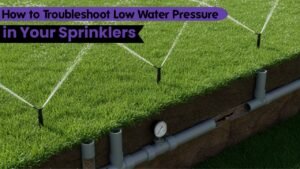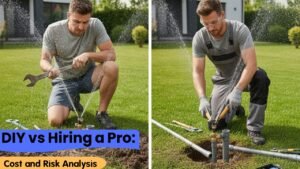Planning to install a sprinkler system? Great move. Whether you want to keep your lawn lush or save water, irrigation systems bring serious benefits. But before you dig a trench or call a contractor, you need one thing—an accurate cost estimate.
That’s where a sprinkler cost calculator comes in. It helps homeowners budget fast. No guesswork. No surprises. Just clear numbers based on your lawn’s size, system type, and preferences.
In this post, I’ll show you how to use a sprinkler cost calculator effectively. I’ll also break down the factors that influence cost, what you can expect by lawn size, and how to plan your budget the smart way.
Why You Need a Sprinkler Cost Calculator
I break down the costs of installing a sprinkler system so homeowners can budget wisely. The youtube video below: HOW MUCH DOES A SPRINKLER SYSTEM COST… by ValleyScape Irrigation & Outdoor Lighting (YouTube, January 5, 2021) explains factors that influence pricing, from materials to labor, helping you plan effectively.
Sprinkler systems aren’t one-size-fits-all. Every yard is different. Soil, slope, climate, and layout all affect cost. A cost calculator takes these into account and gives you a ballpark estimate in minutes.
Here’s what a quality calculator typically factors in:
- Lawn square footage
- Number of zones needed
- System type (spray vs. drip)
- Water source (city or well)
- Smart controller options
- Labor costs in your region
- Permit and backflow requirements
It’s not a final quote, but it gets you close. Close enough to make smart decisions about DIY vs. pro installs or what features you can afford.
Key Inputs in a Sprinkler Cost Calculator
Let’s look at the major inputs that go into a solid cost estimate:
1. Lawn Size
The most critical factor. Larger lawns need more piping, sprinkler heads, valves, and time to install.
| Lawn Size | Zones Needed | DIY Cost Estimate | Pro Install Estimate |
|---|---|---|---|
| ¼ acre (10,000 sq ft) | 3–4 zones | $1,000–$2,000 | $3,000–$5,000 |
| ½ acre | 5–7 zones | $1,800–$3,000 | $5,000–$8,000 |
| 1 acre | 8–10+ zones | $2,500–$4,000 | $8,000–$13,000 |
Calculators will usually ask for square footage. If you don’t know it, use satellite mapping tools like Google Earth or a yard mapping app.
2. Sprinkler Type
Spray heads cover wide, open areas. Rotors work well for large lawns. Drip irrigation suits gardens and narrow beds. Each has different price points.
- Spray heads: $2–$5 each
- Rotor heads: $10–$25 each
- Drip lines: $0.50–$1 per foot
Spray systems are cheaper but use more water. Drip systems are more efficient but cost more upfront.
3. Water Pressure and Source
A calculator might ask if you use city water or a private well. Low water pressure may require booster pumps or pressure regulators. That adds to your cost.
- Pressure regulator: $40–$100
- Pump (for wells): $300–$700
- Backflow preventer: $150–$300
City regulations may require backflow devices. Some even mandate annual testing. Always check with your local building department.
4. Controller Type
You’ll choose between basic timers and smart Wi-Fi controllers. Smart systems adjust watering schedules based on real-time weather data. They cost more upfront but save money long-term.
- Basic controller: $50–$150
- Smart controller: $150–$400
- Sensors (rain, soil, freeze): $30–$100 each
Smart controllers cut down on waste and qualify for rebates in many U.S. cities. Want to know how the controller price stacks up against your overall budget? Check out the full installation cost breakdown: labor vs. materials.
5. Labor and Installation
If you’re going pro, the calculator will estimate labor based on average local rates. Labor can make up 50% or more of your total cost.
- Basic install (¼ acre): 1–2 days
- Larger systems: up to a week
- Rocky or sloped yards take longer
- Labor rates: $50–$125/hour (varies by state)
What the Calculator Won’t Tell You (But You Should Know)
No calculator can capture every variable. You’ll want to account for:
- Permit fees: $50–$300 depending on your city
- Landscape restoration: after trenching, expect to reseed or re-sod
- Winterization costs: especially in cold climates where lines must be drained
- Upgrades: like Bluetooth valves, rain sensors, or separate garden drip zones
Also, remember: not all calculators factor in code requirements. Some cities require licensed contractors for any irrigation tied to potable water lines.
DIY vs Professional Cost Estimates via Calculator
When you plug your info into a calculator, it might give two separate ranges:
- DIY Cost: Based on retail prices for materials, tool rentals, and your labor being free
- Professional Cost: Includes commercial-grade parts, labor, permits, and warranties
Here’s a rough breakdown of what each includes:
| Expense Category | DIY Estimate | Professional Estimate |
|---|---|---|
| Materials | $800–$2,500 | $1,500–$3,500 |
| Tools/Rental | $100–$400 | Included in labor |
| Labor | Your time (free) | $1,500–$5,000+ |
| Permits & Testing | $50–$300 | Usually included |
| Support & Warranty | None | 1–3 years (parts + labor) |
Using the Estimate to Plan Smarter
Once you have your estimate, use it to:
- Compare professional quotes more intelligently
- Decide if DIY is worth the time and effort
- Prioritize features within your budget
- Apply for local water-saving rebates
- Avoid overspending on extras that add little value
Always get at least two or three professional quotes to see how your calculator estimate holds up. Sometimes, regional contractors run seasonal promotions or offer bundled services that beat your DIY cost.
The Best Sprinkler Calculators Online
Looking for a place to start? Try these:
- Rain Bird’s Sprinkler Design Tool – great for system planning
- Home Depot’s Project Calculator – quick material estimates
- IrrigationTutorials.com – offers deep customization and planning help
- Local landscape supplier sites – many offer their own tools tied to regional pricing
Choose a calculator that lets you adjust system type, lawn size, and controller type. The more flexible, the more accurate your estimate will be.
Final Thoughts
A sprinkler cost calculator is your first weapon in budget planning. It brings clarity, control, and confidence before you lay a single pipe.
Use it to size your system smartly. Then compare DIY costs to pro quotes and make the call that fits your time and budget. If you’re stuck deciding what goes where and how deep your wallet needs to be, our full guides on 2025 system costs and installation labor vs. materials have you covered.
Ready to crunch the numbers? Try a calculator today and see how close you are to the lawn you’ve always wanted.




